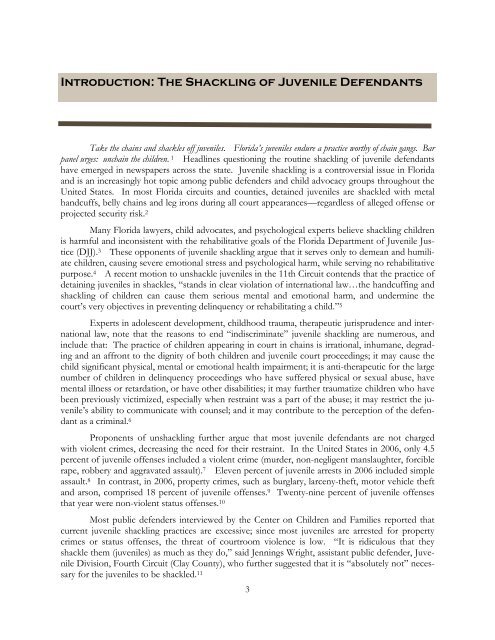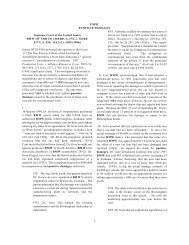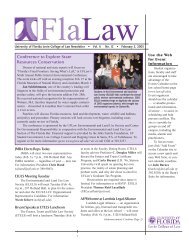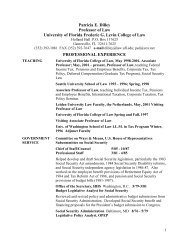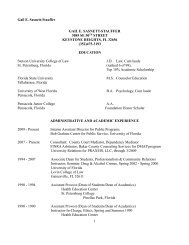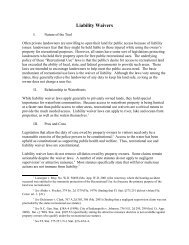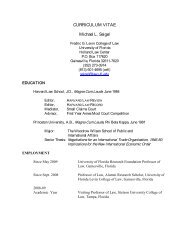The Shackling of The Shackling of Juvenile Offenders: Juvenile ...
The Shackling of The Shackling of Juvenile Offenders: Juvenile ...
The Shackling of The Shackling of Juvenile Offenders: Juvenile ...
You also want an ePaper? Increase the reach of your titles
YUMPU automatically turns print PDFs into web optimized ePapers that Google loves.
Introduction: <strong>The</strong> <strong>Shackling</strong> <strong>of</strong> <strong>Juvenile</strong> Defendants<br />
Take the chains and shackles <strong>of</strong>f juveniles. Florida’s juveniles endure a practice worthy <strong>of</strong> chain gangs. Bar<br />
panel urges: unchain the children. 1 Headlines questioning the routine shackling <strong>of</strong> juvenile defendants<br />
have emerged in newspapers across the state. <strong>Juvenile</strong> shackling is a controversial issue in Florida<br />
and is an increasingly hot topic among public defenders and child advocacy groups throughout the<br />
United States. In most Florida circuits and counties, detained juveniles are shackled with metal<br />
handcuffs, belly chains and leg irons during all court appearances—regardless <strong>of</strong> alleged <strong>of</strong>fense or<br />
projected security risk. 2<br />
Many Florida lawyers, child advocates, and psychological experts believe shackling children<br />
is harmful and inconsistent with the rehabilitative goals <strong>of</strong> the Florida Department <strong>of</strong> <strong>Juvenile</strong> Justice<br />
(DJJ). 3 <strong>The</strong>se opponents <strong>of</strong> juvenile shackling argue that it serves only to demean and humiliate<br />
children, causing severe emotional stress and psychological harm, while serving no rehabilitative<br />
purpose. 4 A recent motion to unshackle juveniles in the 11th Circuit contends that the practice <strong>of</strong><br />
detaining juveniles in shackles, “stands in clear violation <strong>of</strong> international law…the handcuffing and<br />
shackling <strong>of</strong> children can cause them serious mental and emotional harm, and undermine the<br />
court’s very objectives in preventing delinquency or rehabilitating a child.” 5<br />
Experts in adolescent development, childhood trauma, therapeutic jurisprudence and international<br />
law, note that the reasons to end “indiscriminate” juvenile shackling are numerous, and<br />
include that: <strong>The</strong> practice <strong>of</strong> children appearing in court in chains is irrational, inhumane, degrading<br />
and an affront to the dignity <strong>of</strong> both children and juvenile court proceedings; it may cause the<br />
child significant physical, mental or emotional health impairment; it is anti-therapeutic for the large<br />
number <strong>of</strong> children in delinquency proceedings who have suffered physical or sexual abuse, have<br />
mental illness or retardation, or have other disabilities; it may further traumatize children who have<br />
been previously victimized, especially when restraint was a part <strong>of</strong> the abuse; it may restrict the juvenile’s<br />
ability to communicate with counsel; and it may contribute to the perception <strong>of</strong> the defendant<br />
as a criminal. 6<br />
Proponents <strong>of</strong> unshackling further argue that most juvenile defendants are not charged<br />
with violent crimes, decreasing the need for their restraint. In the United States in 2006, only 4.5<br />
percent <strong>of</strong> juvenile <strong>of</strong>fenses included a violent crime (murder, non-negligent manslaughter, forcible<br />
rape, robbery and aggravated assault). 7 Eleven percent <strong>of</strong> juvenile arrests in 2006 included simple<br />
assault. 8 In contrast, in 2006, property crimes, such as burglary, larceny-theft, motor vehicle theft<br />
and arson, comprised 18 percent <strong>of</strong> juvenile <strong>of</strong>fenses. 9 Twenty-nine percent <strong>of</strong> juvenile <strong>of</strong>fenses<br />
that year were non-violent status <strong>of</strong>fenses. 10<br />
Most public defenders interviewed by the Center on Children and Families reported that<br />
current juvenile shackling practices are excessive; since most juveniles are arrested for property<br />
crimes or status <strong>of</strong>fenses, the threat <strong>of</strong> courtroom violence is low. “It is ridiculous that they<br />
shackle them (juveniles) as much as they do,” said Jennings Wright, assistant public defender, <strong>Juvenile</strong><br />
Division, Fourth Circuit (Clay County), who further suggested that it is “absolutely not” necessary<br />
for the juveniles to be shackled. 11<br />
3


